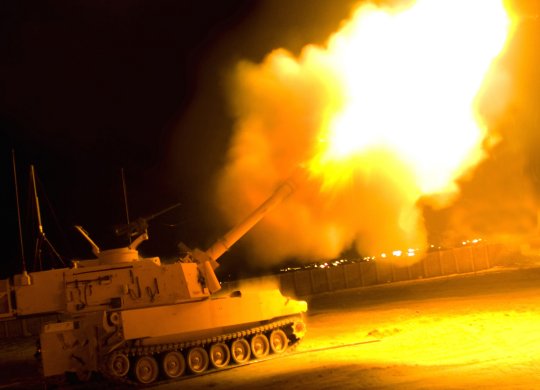« 24th Marine Expeditionary Unit Outside The Wire | Main | The Real Criminals In The Haditha Nightmare »
April 08, 2008
Hooah! The Redleg Soldiers of Howitzer Battery

King of Battle Still Reigns
By Spc. John Crosby
115th Mobile Public Affairs Detachment
MOSUL
The urban terrain of Operation Iraqi Freedom limits the use of large cannons and field artillery units. The days of all out destruction and artillery raining down from the skies seem to be over.
But there are still uses for these Soldiers and instances in which destruction with precision accuracy is vital to the U.S. Army’s mission success.
The Redleg Soldiers of Howitzer Battery, 3d Armored Cavalry Regiment are one of the few field artillery units executing their area of expertise in Iraq today.
The term “Redleg” comes from a time when Cannons were much simpler and the field artilleryman’s uniform was much different. The Army blue uniform for artillerymen had a two-inch red stripe on the trousers and horse artillerymen wore red canvas leggings, distinguishing themselves from other Soldiers.
The Cannons used by Redleg Soldiers were towed by man, horse or mule, providing no protection to the crew operating it. Misfires, muzzle bursts and exploding weapons were not uncommon. Accuracy and reliability were questionable.
Today, the U.S. Army’s M109A6 Paladin self-propelled 155mm howitzer is a tracked vehicle that can reach out and touch a target accurately from 30 km away.
Howitzer Battery uses several strategically placed Paladins located at Badoush Prison located just outside the northern Ninewa province city of Mosul, to support ground troop movement in the area. They conduct an average of three fire missions a night from the combat outpost there, mostly illumination rounds.
“Our role is to support troops in contact with indirect fire, whether it be with 155mm high explosive rounds, Excalibur (guided munitions) or illumination rounds,” said Howitzer Battery Fire Directions Chief, Staff Sgt. Gustavo Martinez.
“We can use guided munitions to support any task or mission and pinpoint areas or buildings,” Martinez continued. “We use illumination rounds to light up an area at night to limit or reveal enemy movement.”
The Paladin is operated by a four man crew consisting of a driver, gunner, cannoneer and chief of section. Howitzer Battery crews work 24 hour shifts in the Paladins at Badoush, on call to support ground troops in contact. After a 24 hour shift, the crew will take 48 hours off to conduct maintenance, chores and guard duty around the combat outpost.
Paladin Gunner, Spc. James Simpson, of Howitzer Battery said working in such a tight quarters with his fellow teammates can lead to skirmishes at times but nothing to serious. His crew works together fluidly.
“You get to know your section and work together really well,” said Simpson.
Still, such a work schedule can lead to boredom. The crews of Howitzer Battery conduct training between fire missions to keep busy.
“We get a lot of training done, more than we did back in Fort Hood,” said Chief of Section, Staff Sgt. Freddy Perdue of Howitzer Battery. “You gotta do something while we’re all in there together for 24 hours straight. But we enjoy our jobs helping the people out there, especially the maneuver forces.”
Perdue said he enjoys doing what he was trained to do. While many Redlegs are taking on the role of a foot soldier in Iraq today, Perdue and Howitzer Battery are carrying on the Redleg legacy.
“Being in the war we are fighting now we can adapt to anything,” said Martinez. “A lot of the guys in our battery are doing infantry tactics and things of that nature. As far as the field artillery guys that are actually doing the field artillery mission, it’s important. You never know. There could be a patrol out there that comes into direct contact with a large group of insurgents and we are here to help by providing indirect fire in a matter of minutes.

Wild Thing's comment........
Goodbye terrorists! Sending you back to Iran and Syria asap!
Posted by Wild Thing at April 8, 2008 02:47 AM
Comments
I wonder how loud it is inside when that cannon fires off?
Posted by: BobF at April 8, 2008 07:06 AM
As a former member of the Regiment I take great pride reading these stories you provide. God bless our "Brave Rifles".. these wonderful "Veterans".
James R McKenna
Troop I 3/3 ACR
1976-1978
Posted by: James R McKenna at April 8, 2008 07:31 AM
Can't they have live fire practice in San Fransicko or Cal Berkeley?
Posted by: drstrangeloveb52isok at April 8, 2008 11:49 AM
Love it, get some!!! Bob, I dunno about the 155 up close but a 105 isn't bad inside the vehicle, just don't get behind the recoilless end, now if you are upright in the turret facing the muzzle it will 'talk' to you and you will hear it, you might even blink, after that they aren't near as loud. Darth, yes!!!:)
Posted by: Jack at April 8, 2008 01:17 PM
If anyone out there would like more info on what it was like in an artillery Battery, specifically in Vietnam, there is a small book (95 pages) called "Brave Cannons" by retired Col. Bohdan Prehar, Ph.D. It covers the activities of the 1/92 Field Artillery in Vietnam. It is available directly from 'Bo' at the Brave Cannons website, www.bravecannons.org
TB
Posted by: tango bravo at April 8, 2008 01:28 PM
Thanks Tango Bravo, and James McKenna, combat arms is hard work, I got a taste of it in Armor.
Back towards the end of '68 I and some of my fellow doggies spent a night outside the perimiter of some small Marine firebase west of Phu Bai in the foothills where we happened to get stuck at night fall, the topography didn't permit our vehicles inside, we just tucked ourselved up against their defensive primeter just below the gun revetments and spent a sleepless night. I don't remember what they were firing, we hauled 105, 155 and 175 ammo to the firebases, it could have been any or all of them.
There were two ridgelines above this firebase with an LP on each one, those guys lost communication to base almost immediately after dark and resorted to voice reporting, everytime the LP shouted out their condition, the enemy sought them out with automatic weapons fire with their green and white tracers in a steady stream, around midnight the NVA mounted an assault, all hell broke loose, it got so bad that the Marines lowered the tubes and fired beehive rounds right over our position, we were too busy to be afraid, but the muzzle blast would rattle your cage, long gone is your hearing, our night vision was gone from the flashes yet you could watch those beehive rounds bounce along the ground in an ever expanding ball of hot steel. Thank you Marines and thank God for another sunrise. I for one wouldn't want to spend a tour in that particular spot where many of you endured that onslaught on a daily basis and had to maintain the fire mission too.
Posted by: Jack at April 8, 2008 10:34 PM
Bob, thanks Jack for answering Bob. I have no idea. I would have just said I would imagine very loud. heh heh
Posted by: Wild Thing at April 9, 2008 12:16 AM
James R McKenna, thank you for serving our country. Thank you too for stopping by and sharing.
Posted by: Wild Thing at April 9, 2008 12:19 AM
drstrangeloveb52isok, heh heh that would be good to.
Posted by: Wild Thing at April 9, 2008 12:21 AM
Tango Bravo, that is great! Thank you so much for the information and the name of the website.
Posted by: Wild Thing at April 9, 2008 12:27 AM
Jack wow, thank you for sharing about that.
Posted by: Wild Thing at April 9, 2008 12:29 AM
